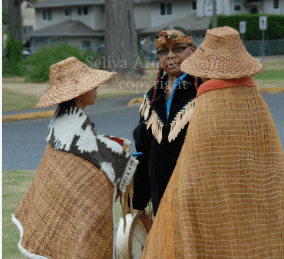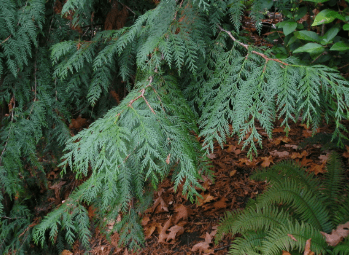Red Cedar trees in particular were and are a very important plant to not only the K’omoks people but also Indigenous people across Vancouver Island. The Red Cedar tree is referred to as the “tree of life” by the Coastal Salish people, as they used it for clothing, shelter, transportation, ceremony, and medicine. The Western Red Cedar was an incredibly important part of everyday life. In the learning that I have done over the past few years, I have learned a lot about the significance of Red Cedar and come to respect it even more whenever I see them during forest walks, and I have also created a more personal connection to it, through using its leaves myself.
Many different parts of the Red Cedartree are and were harvested sustainably to ensure the health of the tree and the ability for generational use. The wood, inner bark, branches, leaves and roots were all used for different things. Red Cedar was used for all types of clothing, such as for everyday wear, shawls, hats, diapers, and blankets. All of these things were most commonly made from the inner bark of the tree. Other uses of the inner bark were for cordage, fishing nets, bags, temporary shelters, makeshift canoes, first aid, bedding, towels, napkins, and tinder (Mapes, Lynda V.).
The wood of the cedar tree, whichis rot resistant, was used to make planks for building houses, canoes, paddles, cradleboards and cradles for babies, boxes for personal belongings and food,
fish lures, fish weirs, harpoons, bows, arrows, bowls, utensils, totem poles, masks, musical instruments, looms, grave houses, and burial boxes (Mapes, Lynda V.).
Branches of varying sizes wereused for ropes, making clam baskets, fish traps, and could be bent to create natural location markers, to mark a certain area or territory (Mapes, Lynda V.). Leaves were used medicinally intea, as well as having a ceremonial meaning, as Cedar is known for being purifying, therefore, was used in many different ceremonies to cleanse the air or body. Cedar branches were laid on the ground as mats and also used for smudging, etc. (Mapes, Lynda V.). Finally, the roots were used forweaving baskets, cradles, hats, and for making cordage (Mapes, Lynda V.).
Cedar has always had a veryimportant role in Coastal Indigenous cultures, and I have learned a lot about the different uses and cultural significance through the learning that I have done in school. For example, when I was researching stories about the Great Flood on Vancouver Island, I came across a story that showed the historical importance of Cedar clothing to the Líl̓watpeople during the time of the Great Flood. During this time, many of the young people were starting to disregard traditional practices and move away from them and had started wearing fur clothing instead of cedar clothing. However, during the time of the Great Flood when the rain began to fall for days on end, those who kept to the traditional ways and who wore cedar clothing had a much easier time, as the cedar clothing was wterproof, light and did not weight you down like the fur did (Nelson, Attila).

A connection to language that islearned, is through my research into the Kwak’wala language. The Kwak’wala language shows a cultural connection to cedar in it’s vocabulary, as the language contains 40+ words related to cedar, to the tree itself, its different parts, and its different uses (Lyall, Andrea).

I have also gained a personal connection to this tree, which has deepened my understanding of the land on which I live. Through my learning about the Red Cedar tree and it’s historical and cultural significance, I have gained deep respect for it. I have also created a personal connection through learning to harvest the leaves for medicinal tea during flu season. I learned how to identify the Red Cedar, harvest its leaves sparingly on each tree, and I always show my respect and gratitude for the tree when harvesting, by asking permission from the tree. I really enjoy Red Cedar tea and it always reminds me of the abundance and medicine that grows all
around me on the land in the Comox Valley.
Resources:
---. www.our-story.ca/winners/writing/7141:the-great-flood.
Indigenous Arts and Stories - the Great Flood. www.our-story.ca/winners/writing/7141:the-great-flood.
Mapes, Lynda. “The Pacific Northwest trees shaped by generations of people.” The Seattle Times, 12 Nov. 2023, www.seattletimes.com/seattle-news/environment/the-pacific-northwest-trees-shaped-by-generations-of-people.
Terralingua. “Linking Language and the Land: How Words, Stories, and Ceremonies Can Inform Discussion Around Decision Making for the Kwakwa̱Ka̱’wakw Peoples and Ceremonies - Terralingua.” Terralingua, 11 Nov. 2024, terralingua.org/stories/linking-language-and-the-land.